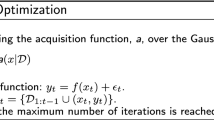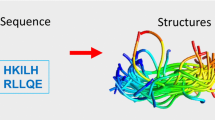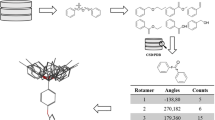Abstract
This paper describes a new and efficient stochastic conformational sampling method for generating a range of low-energy molecule conformations. Sampling can be tailored to a specific structural domain (e.g., peptides) by extracting torsional profiles from specific datasets and subsequently applying them to target molecules outside the reference set. The programs that handle creation of the knowledge-based torsional profiles and conformer generation per se are separate and so can be used independently or sequentially, depending on the task at hand. The conformational ensembles produced are contrasted with those generated using local minimization approaches. They are also quantitatively compared with a broader range of techniques in terms of speed and the ability to reproduce bound ligand conformations found in complexes with proteins.









Similar content being viewed by others
References
Smellie A, Teig SL, Towbin P (1995) J Comp Chem 16:171–187
Cato SJ (2000) In: Güner O (ed) Pharmacophore perception, development, use in drug design. International University Line, La Jolla CA, pp 107–125
Beusen DD, Shands EFB, Karasek SF, Marshall GR, Dammkoehler RA (1996) J Mol Struct: Theochem 370:157–171
Sadowski J, Gasteiger J, Klebe G (1994) J Chem Inf Comput Sci 34:1000–1008
Meng EC, Shoichet BK, Kuntz ID (1992) J Comp Chem 13:505–524
Venkatachalam CM, Jiang X, Oldfield T, Waldman M (2003) J Mol Graph Model 21:289–307
Friesner RA, Banks JL, Murphy RB, Halgren TA, Klicic JJ, Mainz DT, Repasky MP, Knoll EH, Shelley M, Perry JK, Shaw DE, Francis P, Shenkin PS (2004) J Med Chem 47:1739–1749
Jones G, Willett P, Glen RC, Leach AR, Taylor R (1997) J Mol Biol 267:727–748
Jones G, Willett P, Glen RC (1995) J Comput-Aided Mol Des 9: 532–549
Hurst T (1994) J Chem Inf Comput Sci 34:190–196
Jain AN (2003) J Med Chem 46:499–511
Smellie A, Kahn SD, Teig SL (1995) J Chem Inf Comput Sci 35:285–294
Martin YC, Bures MG, Danaher EA, DeLazzer J, Lico I, Pavlik PA (1993) J Comput-Aided Mol Des 7:83–102
Smellie A, Kahn SD, Teig SL (1995) J Chem Inf Comput Sci 35:295–304
CONFORT® was developed by R.S. Pearlman and R. Balducci at the University of Texas, Austin, and is distributed by Tripos International, 1699 S. Hanley Rd., St. Louis MO 63144 USA (http://www.tripos.com)
SYBYL® and GALAHAD™ are distributed by Tripos International, 1699 S Hanley Rd, St. Louis MO 63144 USA ( http://www.tripos.com)
OMEGA is a product of OpenEye Science Software, 3600 Cerrillos Road Suite 1107, Santa Fe NM 87508 USA ( http://www.eyesopen.com)
Vieth M, Hirst JD, Brooks CL III (1998) J Comput-Aided Mol Des 6:563–572
Perola E, Charifson PS (2004) J Med Chem 47:2499–2510
Boström J, Norrby P-O, Liljefors T (1998) J Comput-Aided Mol Des 12:383–396
Boström J (2001) J Comp-Aided Mol Des 15:1137–1152
Strizhev A, Wolohan P, Choi S, Abrahamian E, Clark RD (2006) J Chem Inf Model 46:1862–1870
KBProf and KBConf are trademarks of Tripos L.P
Nissink JW, Murray C, Hartshorn M, Verdonk ML, Cole JC, Taylor R (2002) Proteins 49:457–471
Ash S, Cline MA, Homer RW, Hurst T, Smith GB (1997) J Chem Inf Comput Sci 37:71–79
Homer RW, Clark RD, Hurst T, Jilek RJ, Swanson: SYBYL Line Notation (SLN): a single notation to represent chemical structures, queries, reactions, virtual libraries (manuscript in preparation)
For details, see http://www.tripos.com/mol2/atom_types.html
LeadQuest® is a available from Tripos Discovery Research Centre, Bude-Stratton Business Park, Bude Cornwall EX23 BLY UK ( http://www.leadquest.com)
Halgren TA (1996) J Comp Chem 17:490–641
Halgren TA (1999) J Comp Chem 20:720–748
Takahashi Y, Sukekawa M, Sasaki S-I (1992) J Chem Inf Comput Sci 32:639–643
Gillet VJ, Willett P, Bradshaw J (2003) J Chem Inf Comput Sci 43:338–345
Rarey M, Dixon JS (1998) J Comput-Aided Mol Des 12:471–490
Berman HM, Westbrook J, Feng Z, Gilliland G, Bhat TN, Weissig H, Shindyalov IN, Bourne PE (2000) Nucl Acids Res 28:235–242 ( http://www.rcsb.org/pdb)
http://www.ebi.ac.uk/thornton-srv/databases/pdbsum/index.html
CONCORD® was developed by R.S. Pearlman, A. Rusinko, J.M. Skell and R. Baducci at the University of Texas, Austin, and is distributed exclusively by Tripos International, 1699 S. Hanley Rd., St. Louis MO 63144
Boström J, Greenwood JR, Gottfries J (2001) J Mol Graph Model 21:449–462
McMartin C, Bohacek R (1997) J Comput-Aided Mol Des 11:333–344
Kirchmair J, Wolber G, Laggner C, Langer T (2006) J Chem Inf Model 46:1848–1861
Sadowski J, Boström J (2006) J Chem Inf Model 46:2305–2309
Klebe G, Mietzner T (1994) J Comput-Aided Mol Des 8:583–606
Krystek SR Jr, Hunt JT, Stein PD, Stouch TR (1995) J Med Chem 38:659–668
Acknowledgments
Many thanks to Dr. Edmond Abrahamian (Tripos) for infusing common sense into this publication, noting errors, suggesting additional areas to cover, and asking searching questions.
Author information
Authors and Affiliations
Corresponding author
Appendices
Appendix A: Substructure standardization rules

Appendix B: Rotatable bond definitions used

Rights and permissions
About this article
Cite this article
Dorfman, R.J., Smith, K.M., Masek, B.B. et al. A knowledge-based approach to generating diverse but energetically representative ensembles of ligand conformers. J Comput Aided Mol Des 22, 681–691 (2008). https://doi.org/10.1007/s10822-007-9156-5
Received:
Accepted:
Published:
Issue Date:
DOI: https://doi.org/10.1007/s10822-007-9156-5




